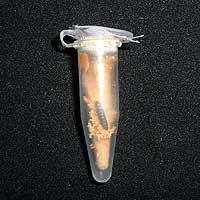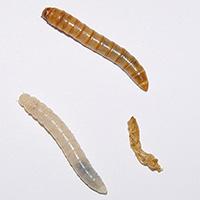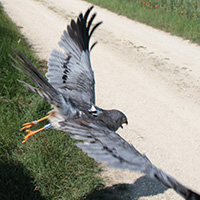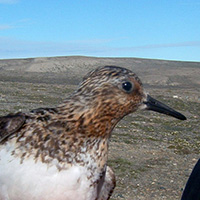UMR 6282 Biogéosciences
université de Bourgogne
6 bd Gabriel
21000 Dijon, France
Domaines de recherche
 1) Effet du réchauffement climatique sur les interactions tri-trophiques entre la vigne, les vers de la grappe et leurs ennemis naturels
1) Effet du réchauffement climatique sur les interactions tri-trophiques entre la vigne, les vers de la grappe et leurs ennemis naturels
2) Effet des caroténoïdes et des parasites intestinaux sur l’immunité et la sélection sexuelle chez le merle noir
 3) Transfert transgénérationnel d’immunité chez Tenebrio molitor
3) Transfert transgénérationnel d’immunité chez Tenebrio molitor
 4) Effet latent des produits phytosanitaires sur les oiseaux des plaines agricoles (Centre d’études biologiques de Chizé)
4) Effet latent des produits phytosanitaires sur les oiseaux des plaines agricoles (Centre d’études biologiques de Chizé)
5) Effet de la personnalité des parasitoïdes dans les programmes de lutte biologique
 6) Effet de la dynamique cyclique des lemmings sur la structuration des communautés arctiques et sur les stratégies de reproduction des limicoles. (Programme IPEV)
6) Effet de la dynamique cyclique des lemmings sur la structuration des communautés arctiques et sur les stratégies de reproduction des limicoles. (Programme IPEV)
Diplomes universitaires et situations antérieures
2017-2018 : Délégation à mi temps au CNRS au Centre d’études biologiques de Chizé.
2016-2017 : Délégation à plein temps au CNRS au Centre d’études biologiques de Chizé.
2003-2004 : post-doctorat à l’université de Neuchâtel, Suisse.
2002 : ATER (Attaché Temporaire à l’Enseignement et à la Recherche) en Biostatistiques à l’UFR des Sciences de la vie de l’Université de Bourgogne au Laboratoire Écologie-Évolution, Dijon.
1999-2001 : Doctorat Sciences de la vie. Allocataire MENRT. Université de Tours. Mention très honorable avec les félicitations du Jury.
Titre de la thèse : Impact des bactéries intracytoplasmiques féminisantes Wolbachia chez les isopodes terrestres : interactions entre sex-ratio anormale et stratégies de reproduction. Thèse effectuée au Laboratoire « Génétique et Biologie des Populations de Crustacés », (UMR CNRS 6556), Poitiers (86).
Etudiants en thèse
2021-2023 : Elva Fuentes :Effets des pesticides sur les poussins de Busard cendré (1 publication). Co-encadrement en collaboration avec Karine Monceau (Mcf)
2019-2022 : Gaffard Agathe : Écologie et reproduction de la perdrix grise sur la Zone Atelier Plaine & Val de Sèvre : effets des pesticides et propositions de gestion en lien avec la fédération des chasseurs et les programmes de renforcement.
2017-2020 : Lartigue Silène : Prise en compte de la personnalité animale dans les programmes de lutte biologique. Co-encadrement en collaboration avec Thibaut Malaussa (CR, INRA)
2016-2020 : Castex Victorine : Effet du réchauffement climatique sur la vigne et ses ravageurs : utilité de la modélisation. Co-encadrement en collaboration avec Dominique Fleury, Pierluigi Calanca et Martin Beniston. Université de Génève
2016-2019 : Iltis Corentin : Effet du réchauffement climatique sur le système immunitaire des ravageurs et son impact sur les interactions tritrophiques. Co-encadrement en collaboration avec Philippe Louâpre (Mcf)
2012-2015 : Muller Karen : Rôle du mâle sur les performances reproductrices des femelles phytophages : importance de la plante hôte
2011-2014 : Vogelweith Fanny : Effet de la plante hôte sur l’immunité des insectes phytophages : influence du cépage de vigne sur la capacité de vers de la grappe à se défendre contre des bio-agresseurs
2010-2012 : Zanchi Caroline : Ecologie évolutive et mécanismes de transfert d’immunité transgénérationnelle chez les insectes. Co-encadrement en collaboration avec Yannick Moret (CR, CNRS, HDR)
Publications
A) Publications dans des revues à comité de lecture
A105) Garinie T., Nusillard W., Lelièvre Y., Taranu Z.E., Goubault M., Thiéry D., Moreau J. and Louâpre P. (2024). Adverse effects of heavy metals in vineyards: impact of a copper-based fungicide on the non-target pest Lobesia botrana. Pest Management Science, in press.
A104) Pagnon T., Etchart L., Teixeira M., Dechaume-Moncharmont F.X., Hallgrimsson G.T., Hansen J., Lang J., Moreau J., Reneerkens J., Schmidt N.M., Soloviev M., Horn J.T., Tomkovitch P., Wood A.G., Yannic G., Bollache, L. and Gilg O. (2024). Considering geographical and temporal variations in body size and sexual size dimorphism in morphometric-based birds sexing. Journal of Ornithology, in press.
A103) Fuentes E., Moreau J., Millet M., Bretagnolle V. and Monceau K. (2024). Organic farming reduces pesticide load in a bird of prey. STOTEN, in press.
A104) Etchart L., Lecomte N., Dechaume Moncharmont F.X., Moreau J., Lang J., Sittler B., Teixeira M., Bollache L. and Gilg O. (2024). Large variability in nesting behaviour of arctic birds: how extended incubation recesses are linked to ground temperatures and lower body conditions. Proceedings of Royal Society of London B, in press.
A103) Nusillard W., Garinie T., Lelièvre Y., Moreau J., Thiéry D., Groussier G., Frandon J. and Louâpre P. (2023). Heavy metals used as fungicide may positively affect Trichogramma species used as biocontrol agents in IPM programs. Journal of Pest Science, https://doi.org/10.1007/s10340-023-01624-6.
A102) Fuentes E., Moreau J., Teixeira M., Bretagnolle V. and Monceau K. (2023). Effects of conventional vs. organic farming practices on raptor nestling health: Neither black nor white. Agriculture, Ecosystems and Environment, 358, 108719.
A101) Fuentes E., Gaffard A., Rodrigues A., Millet M., Bretagnolle V., Moreau J. and Monceau K. (2023). Neonicotinoids: Still present in farmland birds despite their ban. Chemosphere, 321, 138091
A100) Castex V., García de Cortázar-Atauri I., Beniston M., Moreau J., Semenov M.A., Stoffel M. and Calanca P. (2023). Exploring future changes in synchrony between grapevine (Vitis vinifera) and its major insect pest, Lobesia botrana. Oeno One, 57(1), 161-174.
A99) Rodrigues A., Gaffard A., Moreau J., Monceau K., Delhomme O. and Millet M. (2023). Analytical development for the assessment of pesticide contaminations in blood and plasma of wild birds: the case of grey partridges (Perdix perdix). Journal of Chromatography A, 1687, 463681.
A98) Moreau J., Rabdeau J., Badenhausser I., Giraudeau M., Sepp T., Crépin M., Gaffard A., Bretagnolle V. and Monceau K. (2022). Pesticide impacts on avian species with special reference to farmland birds: a review. Environmental Monitoring and Assessment, 194(10):790.
A97) Depeux C., Branger A., Moulignier T., Moreau J., Lemaître J.F., Dechaume-Moncharmont F.X., Laverre T., Pauhlac H., Gaillard J.M. and Beltran-Bech S. (2022). Deleterious effects of thermal and water stresses on life history and physiology: a case study on woodlouse. bioRxiv, 2022.09.26.509512, ver. 3 peer-reviewed and recommended by Peer Community in Ecology. https://doi.org/10.1101/2022.09.26.509512
A96) Gaffard A., Pays O., Monceau K., Teixeira M., Bretagnolle V. and Moreau J. (2022). Feeding on grains containing pesticide residues is detrimental to offspring development through parental effects in grey partridge. Environmental Pollution, 312, 120005.
A95) Rabdeau J., Desbonnes M., Bretagnolle V., Moreau J. and Monceau K. (2022). Does anthropization affect the physiology, the behaviour and the life-history traits of Montagu’s harrier chicks. Animal Conservation, 10.1111/acv.12810
A94) Gaffard A., Loiseau C., Bretagnolle V., Pays O. and Moreau J. (2022). Sublethal effects of pesticides residuals differ according to two strains of captive Grey partridge: consequences in terms of rearing condition. Applied Animal Behaviour Sciences soumis.
A93) Moreau J., Monceau K., Gonnet G., Pfister M. and Bretagnolle V. (2022). Organic farming positively affects vitality behavior of passerine birds in agricultural landscape. Agriculture, Ecosystems and Environment, in press.
A92) Lartigue S., Yalaoui M., Belliard J., Caravel C., Jeandroz L., Groussier G., Calcagno V., Louâpre P., Dechaume-Moncharmont F.-X., Malausa T. and Moreau J. (2022). Consistent variations in personality traits and their potential for genetic improvement of biocontrol agents. Evolutionary Ecology, 10.1111/eva.13329, in press.
A91) Louâpre P., Muller K., Bettencourt-Amarante S., Thiéry D. and, Moreau J. (2022). Sexual audience affects male’s reproduction investment without consequences on reproductive outputs. Insect Science, in press.
A90) Biard C., Monceau K., Teixeira M., Motreuil S., Bettencourt-Amarante S., Develay L. and Moreau J. (2022). Coccidial oocyst release: once a day or all day long? Tropical bird hosts shed new light on the adaptive significance of diurnal periodicity in parasite output. Parasitology, 149, 469-481.
A89) Iltis C., Moreau J., Hubner P., Thiéry D. and Louâpre P. (2022). Warming increases tolerance of an insect pest to fungicide exposure through temperature-mediated hormesis. Journal of Pest Science, 95, 827-839.
A88) Iltis C., Moreau J., Gamb G., Manière C, Boidin-Wichlacz C, Tasiemski A, Thiéry D. and Louâpre P. (2021). Day/night variations of feeding and immune activities in larvae of the European grapevine moth, Lobesia botrana. Entomologia Generalis, 41(6), 601-614.
A87) Harmange C., Bretagnolle V., Pays O., Sarasa M. and Moreau J., (2021). Linking personality and health to space use in the gray partridge: perspective for management European Journal of Wildlife Research, 67(5), 81.
A86) Moreau J., Monceau K., Crépin M., Derouin Tochon F., Mondet C., Frainkin M., Teixeira M. and Bretagnolle V. (2021). Feeding partridges with organic or conventional grain triggers cascading effects in life-history traits. Environmental Pollution, 278, 116851.
A85) Iltis C., Louâpre P., Vogelweith F., Thiéry D. and Moreau J. (2021). How to stand the heat? Post-stress nutrition and developmental stage determine insect response to a heat wave. Journal of Insect Physiology, 131, 104214.
A84) Rabdeau J., Badenhausser I., Gaffard A., Mangelinck C., Moreau J., Bretagnolle V. and Monceau K. (2021). Assortative pairing for boldness and consequences for reproductive success in Montagu’s harrier. Biological Journal of the Linnean Society, 132(4), 759-773.
A83) Meyer N., Bollache L., Galipaud M., Moreau J., Dechaume-Moncharmont F.X., Afonso E., Angerbjörn A., Bêt J., Brown G., Ehrich D., Gilg V., Giroux M.A., Hansen J., Lanctot R., Lang J., Latty C., Lecomte N., McKinnon L., Kennedy L., Reneerkens J., Saalfeld S., Sabard B., Schmidt N.M., Sittler B., Smith P., Sokolov A., Sokolov V., Sokolova N., van Bemmelen R., Varpe O. and Gilg O. (2021). Behavioural responses of arctic sandpipers to ground surface temperature and primary production during incubation. Sciences of Total Environment, 755(2), 142485.
A82) Lartigue S., Yalaoui M., Belliard J., Caravel C., Jeandroz L., Groussier G., Calcagno V., Louâpre P., Dechaume-Moncharmont F.-X., Malausa T. and Moreau J. (2020). Consistent variations in personality traits and their potential for genetic improvement of biocontrol agents: Trichogramma evanescens as a case study. bioRxiv, 2020.08.21.257881, ver. 4 peer-reviewed and recommended by PCI Ecology. doi: https://doi.org/10.1101/2020.08.21. 257881
A81) Depeux C., Lemaître J.F., Moreau J., Dechaume-Moncharmont F.X., Laverre T., Pauhlac H., Gaillard J.M. and Beltran-Bech S. (2020). Reproductive senescence and parental effects in an indeterminate grower. Journal of Evolutionary Biology, 33(9), 1256-1264.
A80) Meyer N., Bollache L., Galipaud M., Moreau J., Dechaume-Moncharmont F.X., Afonso E., Angerbjörn A., Bêt J., Brown G., Ehrich D., Gilg V., Giroux M.A., Hansen J., Lanctot R., Lang J., Latty C., Lecomte N., McKinnon L., Kennedy L., Reneerkens J., Saalfeld S., Sabard B., Schmidt N.M., Sittler B., Smith P., Sokolov A., Sokolov V., Sokolova N., van Bemmelen R., Varpe O. and Gilg O. (2020). Nest attentiveness drives nest predation in arctic sandpipers. Oikos, 129(10), 1481-1492.
A79) Babin A., Motreuil S., Teixeira M., Baueur A., Rigaud T., Moreau J. and Moret Y. (2020). Origin of the natural variation in the storage of dietary carotenoids in crustaceans. PlosOne, 15(4): e0231247.
A78) Castex V., García de Cortázar-Atauri I., Calanca P., Beniston M. and Moreau J. (2020). Assembling and testing a generic phenological model to predict Lobesia Botrana voltinism for impact studies. Ecological Modelling, 420, 108946.
A77) Depeux C., Samba-louaka A., Becking T., Braquart-Varnier C., Moreau J., Lemaître J.F., Laverre T., Pauhlac H., Dechaume-Moncharmont F.X., Gaillard J.M. and Beltran-Bech S. (2020). The crustacean Armadillidium vulgare (Latreille, 1804) (Isopoda: Oniscoidea), a new promising model for the study of cellular senescence. Journal of Crustacean Biology, 40(2), 194-199.
A76) Iltis C., Moreau J., Pecharova K., Thiéry D. and Louâpre P. (2020). Reproductive performance of the European grapevine moth Lobesia botrana (Tortricidae) is adversely affected by warming scenario. Journal of Pest Science, 93, 679-689.
A75) Iltis C., Moreau J., Manière C., Thiéry D., Delbac L. and Louâpre P. (2020). Where you come from matters: temperature influences host-parasitoid interaction through parental effects. Oecologia, 192, 853-863.
A74) Babin A., Moreau J. and Moret Y. (2019). Storage of carotenoids in crustaceans as an adaptation to modulate immunopathology and optimize immunological and life-history strategies. BioEssays, 41(11),1800254.
A73) Lefebvre F., Richard F-J, Moreau J., Rigaud T. and Caubet Y. (2019). Mass drives mating success in Armadillidium vulgare (Crustacea, Oniscidea). Behavioural Processes, 168,103944.
A72) Iltis C., Louâpre P., Pecharová K. Thiéry D., Zito S., Bois B. and Moreau J. (2019). Are life-history traits equally affected by global warming? A case study combining a multi-trait approach with fine-grain climate modeling. Journal of Insect Physiology, 117,103916.
A71) Rabdeau J., Badenhausser I., Moreau J., Bretagnolle V. and Monceau K. (2019). To change or not experimenters: Caveats for repeated behavioral and physiological measures. Journal of Avian Biology, 50(8), JAV12618.
A70) Moreau J., Buffenoir N., Thiéry D. and Vogelweith F. (2019). Lobesia botrana as a preferred host of Campoplex capitator, the most occurring larval parasitoid in European vineyards. Entomologia Generalis, 39(3-4), 307-312.
A69) Gilg O., Bollache L., Afonso E., Yannic G., Schmidt N. M., Hansen L. H., Hansen J., Sittler B., Lang J., Meyer N., Sabard B., Gilg V., Lang A., Lebbar M., Haukisalmi V., Heikki H. and Moreau J. (2019). Are gastrointestinal parasites associated with the population dynamics of their cyclic arctic lemming hosts? International Journal for Parasitology: Parasites and Wildlife, 10, 6-12.
A68) Bollache L., Bardet E., Depret G., Motreuil S., Neuwirth C., Moreau J. and Hartmann A. (2019). Dissemination of CTX-M-producing Escherichia coli in freshwater fishes from a French Watershed (Burgundy). Frontiers in Microbiology, 9:3239. doi: 10.3389/fmicb.2018.03239.
A67) Iltis C., Martel G., Thiéry D., Moreau J. and Louâpre P. (2018). When warmer means weaker: high temperatures reduce behavioural and immune defences displayed by grape pest larvae Lobesia botrana. Journal of Pest Science, 91, 1315-1326.
A66) Amat I., Desouhant E., Gomes E., Moreau J. and Monceau K. (2018). Insect personality: what can we learn from metamorphosis? Current Opinion in Insect Sciences, 27, 46-51.
A65) Castex V., Beniston M., Calanca P., Fleury D. and Moreau J. (2018). Pest management under climate change: the importance of understanding tritrophic relationship. Science of Total Environment, 616-617, 397-407.
A64) Thiéry D., Louâpre P., Muneret L., Rusch A., Sentenac G., Vogelweith F., Iltis C. and Moreau J. (2018). Trusting biological control against the grapevine moths: potential and perspectives. Agronomy for Sustainable Development, 38:15.
A63) Moreau J., Perroud L., Bollache L., Yannic G., Teixeira M., Martin Schmidt N., Reneerkens J. and Gilg O. (2018). Discriminating uni- versus biparental breeding strategies by monitoring nest temperature. Ibis, 160, 13-22.
A62) Iltis C., Dechaume-Moncharmont F.X., Galipaud M., Moreau J., Bollache L. and Louâpre P. (2017). Love me tender love me long: males and females both gain from precopulatory mate guarding. Animal Behaviour, 130, 67-72.
A61) Germond A., Kumar V., Ichimura T., Moreau J., Furusawa C., Fujita H. and Watanabe T.M. (2017). Raman spectroscopy as a tool for ecology and evolution. Journal of the Royal Society Interface, 14, 20170174.
A60) Vogelweith F., Thièry D., Moret Y., Delbac L. and Moreau J. (2017). No evidence of an immune adjustment in response to a parasitoid threat in Lobesia botrana larvae. Journal of Insect Physiology, 102, 7-11.
A59) Monceau K., Dechaume-Moncharmont F.X., Moreau J., Lucas C., Capoduro R., Sauvage J., Motreuil S. and Moret Y. (2017). Personality, immune response and reproductive success: An appraisal of the pace-of-life syndrome hypothesis. Journal of Animal Ecology, 86, 932-942.
A58) Muller K., Thiéry D., Delbac L. and Moreau J. (2017). Mating patterns of the European grapevine moth (Lobesia botrana) in sympatric and allopatric populations. Biological Journal of Linnean Society, 120(3), 685-699.
A57) Monceau K., Moreau J., Richet J., Montreuil S., Moret Y. and Dechaume-Moncharmont F.-X. (2017). Larval personality does not predict adult personnalité in a holometabolous insect. Biological Journal of the Linnean Society, 120, 869-878.
A56) Moreau J., Desouhant E., Louâpre P., Goubault M., Rajon E., Jarrige A., Menu F. and Thiéry D. (2017). How Host Plant and Fluctuating Environments Affect Insect Reproductive Strategies? In N. Sauvion, P-A. Calatayud, D. Thiéry (Volume Eds), Advances in Botanical Research series: Vol 81. Insect-Plant Interactions in a Crop Protection Perspective (pp. 259-288). Elsevier, GBR.
A55) Muller K., Thiéry D., Motreuil S. and Moreau J. (2016). What makes a good mate? Factors influencing male and female reproductive success in a polyphagous moth. Animal Behaviour, 120, 31-39.
A54) Reneerkens J., Martin Schmidt N., Gilg O., Hansen J., Hansen L.O., Moreau J. and Piersma T. (2016). Effects of food abondance and early clutch prédation on reproductive timing in a high Arctic shorebird exposed to advancements in arthropode abondance. Ecology and Evolution, 6(20), 7375-7386.
A53) Muller K., Arenas L., Thiéry D. and Moreau J. (2016). Direct benefits from mating with a virgin male in the usually monandrous European grapevine moth (Lobesia botrana). Animal Behaviour, 114, 165-172.
A52) Vogelweith F., Moret Y., Monceau K., Thiéry D. and Moreau J. (2016). The relative abundance of hemocyte types in depends upon the diet of a polyphagous moth larva. Journal of Insect Physiology, 88, 33-39.
A51) Moreau J., Monceau K. and Thiéry D. (2016). Larval food influences oviposition dynamics and egg quality traits in females of Lobesia botrana. Journal of Pest Science, 89, 439-448.
A50) Dubuffet A., Zanchi C., Boutet G., Moreau J., Teixeira M. and Moret Y. (2015). Trans-generational immune priming protects the eggs only against Gram-positive bacteria in the mealworm Beetle. PLoS Pathogens, 11(10): e1005178. doi:10.1371/journal.ppat.1005178
A49) Vogelweith F., Moreau J., Thiéry D and Moret Y. (2015). Food-mediated modulation of immunity in a phytophagous insect: an effect of nutrition rather than parasitic contamination. Journal of Insect Physiology, 77, 55-61.
A48) Biard C., Monceau K., Motreuil S. and Moreau J. (2015). Interpreting immunological indices: the importance of taking parasite community into account. An example in blackbirds (Turdus merula). Methods in Ecology and Evolution, 6, 960-972.
A47) Monceau K., Moreau J., Poidatz J., Bonnard O. and Thiéry D. (2015). Behavioral syndrome in a native and an invasive hymenoptera species. Insect Science, 22, 541-548.
A46) Babin A., Saciat C., Gaillard M., Troussard J.P., Motreuil S., Moreau J., and Moret Y. (2015). Limiting immunopathology: interaction between dietary carotenoids and enzymatic antioxidant defences upon immune-mediated oxidative stress in a crustacean. Developmental and Comparative Immunology, 49, 278-281.
A45) Hansen J., Ek M., Roslin T., Schmidt N.M., Moreau J., Teixeira M. and Gilg O. (2015). First observation of a 4 egg clutch of Long-tailed Skua Stercorarius longicaudus. The Wilson Journal of Ornithology, 127(1), 149-153.
A44) Muller K., Vogelweith F., Thiéry D., Moret Y. and Moreau J. (2015). Immunocompetence benefits from rare host plants maintain polyphagy in an herbivorous insect. Oecologia, 177(2), 467-475.
A43) Muller K., Thiéry D., Moret Y. and Moreau J. (2015). Male larval nutrition affects adult reproductive success in wild European grapevine moth (Lobesia botrana). Behavioral Ecology and Sociobiology, 69(1), 39-47.
A42) Thiéry D., Monceau K. and Moreau J. (2014). Larval intraspecific competition for food in the European grapevine moth Lobesia botrana. Bulletin of Entomological Research, 104, 517-524.
A40) Vogelweith F., Thiéry D., Moret Y., Colin E., Motreuil S. and Moreau J. (2014). Defense strategies used by two sympatric vineyard moth pests. Journal of Insect Physiology, 64, 54-61.
A39) Monceau K., Bonnard O., Moreau J. and Thiéry D. (2014). Spatial Distribution of Vespa velutina Individuals Hunting at Domestic Honeybee Hives: Heterogeneity at a Local Scale. Insect Science, 21, 765-774.
A38) Vogelweith F., Dourneau M., Thiéry D., Moret Y. and Moreau J. (2013). Geographical variation in parasite prevalence shapes larval immunocompetence in the phytophagous european grapevine moth larvae. Naturwissenchaften, 100, 1149-1161.
A37) Monceau K., Cézilly F. Moreau J., Motreuil S. and Wattier R. (2013). Population history of the Zenaida Dove (Zenaida aurita): phylogeography, contemporary gene flow and morphological divergence in the West Indies. PLoS ONE, 8(12), e82189.
A36) Gilg O., Moe B., Hanssen S.A., Schmidt N.M., Sittler B., Hansen J., Reneerkens J., Sabard B., Chastel O., Moreau J., Phillips R.A., Oudman T., Biersma E., Fenstad A.A., Lang J. and Bollache L. (2013). Trans-Equatorial Migration Routes, Staging Sites and Wintering Areas of a High-Arctic Avian Predator: the Long-tailed Skua (Stercorarius longicaudus). PLoS ONE, 8(5), e64614.
A35) Vogelweith F., Moret Y., Thiéry D. and Moreau J. (2013). Insect larvae grow faster in presence of deadly enemies: A Lobesia botrana model. PLoS ONE, 8(8), e72568.
A34) Vogelweith F., Thiéry D., Moret Y. and Moreau J. (2013). Immunocompetence increases with larval body size in phytophagous moths Physiological Entomology, 38, 219-225.
A33) Moret Y. and Moreau J. (2012). The immune role of the arthropod exoskeleton. Invertebrate Survival Journal, 9, 200-206.
A32) Zanchi C., Troussard J.P., Moreau J. and Moret Y. (2012). Relationship between maternal transfer of immunity and mother fecundity in an insect. Proceedings of the Royal Society of London B, 279, 3223-3230.
A31) Gilg O., Kovacs K.M., Aars J., Fort J., Gauthier G., Gremillet D., Ims R.A., Meltofte H., Moreau J., Post E., Martin Schmidt N., Yannic G and Bollache L. (2012). Climate change and the ecology and evolution of Arctic vertebrates. Annals of the new york academy of sciences, 1249, 166-190.
A30) Moreau J., Martinaud G., Troussard J.P., Zanchi C. and Moret Y. (2012). Female body size constrains trans-generational immune priming in an insect. Oikos, 121, 1828-1832.
A29) Vogelweith F., Thiéry D., Quaglietti B., Moret Y. and Moreau J. (2011). Host plant variation plastically impacts different traits of the immune system of a phytophagous insect. Functional Ecology, 25, 1241-1247.
A28) Zanchi C., Troussard J.P., Martinaud G., Moreau J. and Moret Y. (2011). Differential expression and costs between maternally and paternally derived immune priming for offspring in an insect. Journal of Animal Ecology, 80, 1174-1183.
A27) Biard C., Saulnier N., Gaillard M. and Moreau J. (2010). Carotenoid-based bill colour is an integrative signal of multiple parasite infection in blackbirds. Naturwissenchaften, 97, 987-995.
A26.) Moreau J., Villemant C., Benrey, B. and Thiery, D. (2010). Species diversity of larval parasitoids of the European grapevine moth (Lobesia botrana, Lepidoptera: Tortricidae): the influence of region and cultivar. Biological Control, 54, 300-306.
A25.) Moret Y., Rigaud T., Motreuil S., Troussard J.P. and Moreau J. (2010) Condition-dependent ecdysis and immunocompetence in the amphipod crustacean, Gammarus pulex. Biology Letters, 6, 788-791.
A24.) Moreau J., Richard A., Benrey B. and Thièry D. (2009). Host plant cultivars of the grapevine moth Lobesia botrana affects the life history traits of an egg parasitoid. Biological Control, 50, 117-122.
A23.) Biard C., Hardy C., Motreuil S. and Moreau J. (2009). Dynamics of PHA-induced immune response and plasma carotenoids in birds: Should we have a closer look. Journal of Experimental Biology. 212, 1336-1343.
A22.) Filipiak L., Mathieu F. and Moreau J. (2009). Caution on the assessment of intestinal parasitic load in studying parasite-mediated sexual selection: the case of Blackbirds coccidiosis. International Journal for Parasitology, 39, 741-746.
A21.) Martinaud G., Billaudelle M. and Moreau J. (2009). Circadian variation in coccidial oocysts shedding in blackbirds (Turdus merula): an adaptative trait against the desiccation and UV radiation. International Journal for Parasitology, 39, 735-739.
A20.) Lavigne J.P., Nicolas-Chanoine M.H., Bourg G., Moreau J. and Sotto A. (2008). Virulent synergistic effect between Enterococcus faecalis and Escherichia coli assayed by using the Caenorhabditis elegans model. PLoS ONE 3(10): e3370. doi:10.1371/journal.pone.0003370.
A19.) Moreau J., Rahme J., Benrey B. and Thiery D. (2008). Larval host plant origin modifies the adult oviposition preference of the female European grapevine moth Lobesia botrana. Naturwissenschaften, 95, 317–324.
A18.) Baeta R., Faivre B., Motreuil S. and Moreau J. (2008). Carotenoids trade-off between parasitic resistance and sexual displays: an experimental study in the blackbird (Turdus merula). Proceedings of the Royal Society of London B, 275, 427-434.
A17.) Moreau J., Thiery D., Troussard J.P. and Benrey B. (2007). Grape variety affects female but also male reproductive success in wild European grapevine moths. Ecological Entomology, 32, 747-753.
A16.) Verne S., Moreau J., Caubet Y., Bouchon D. and Grandjean F. (2007). Male mating success during parturial intermoults in the terrestrial isopod Armadillidium vulgare revealed by the use of microsatellite locus. Journal of Crustacean Biology, 27(2), 217-219.
A15.) Lavigne J.P., Marchandin H., Delmas J., Moreau J., Bouziges N., Lecaillon E., Cavalie L., Jean-Pierre H., Bonnet R. and Sotto A. (2007). CTX-M-producing Escherichia coli in French hospitals: Prevalence, Molecular Epidemiology and Risk factors. Journal of Clinical Microbiology, 45(2), 620-626.
A14.) Bentz S., Rigaud T., Barroca M., Martin-Laurent F., Bru D., Moreau J. and Faivre B. (2006). Variation in haematozoan intensity in European Blackbird Turdus merula populations revealed by quantitative PCR. Parasitology, 133, 685-692.
A13.) Lavigne J.P., Blanc-Potard A.B., Bourg G., Moreau J., Chanal C., Bouziges N., O’Callaghan D. and Sotto A. (2006). Virulence genotype and nematode killing properties of extraintestinal Escherichia coli producing CTX-M â-lactamases. Clinical Microbiology and Infection, 12(12), 1199-1206.
A12.) Moreau J., Benrey B. and Thiery D. (2006). Assessing larval food quality for phytophagous insects: are facts as simple as it appears? Functional Ecology, 20(4), 592-600.
A11.) Moreau J., Arruego X. Benrey B. and Thiery D. (2006). Differences in nutritional quality of parts of Vitis vinifera berries affect fitness of the European grapevine moth. Entomologia Experimentalis et Applicata, 119, 93-99.
A10.) Moreau J., Benrey B. and Thiery D. (2006). Grape variety affects larval performance and also female reproductive performance of the European Grapevine moth (Lobesia botrana). Bulletin of Entomological Research, 96, 205-212.
A9.) Thièry D. and Moreau J. (2005). Relative performance of European grapevine moth (Lobesia botrana) on grapes and other hosts. Oecologia, 143, 548-557.
A8.) Rigaud T. and Moreau J. (2004).A cost of Wolbachia-induced sex reversal and female-biased sex ratios: decrease in female fertility after sperm depletion in a terrestrial isopod. Proceedings of Royal Society of London B, 271, 1941-1946.
A7.) Moreau J and Rigaud T. (2003). Variable male potential rate of reproduction: high male mating capacity as an adaptation to parasite-induced excess of females? Proceedings of Royal Society of London B, 270, 1535-1540.
A6.) Moreau J, Seguin S, Caubet Y and Rigaud T. (2002). Low re-mating and moderate sperm competition in the terrestrial crustacean Armadillidium vulgare (Isopoda). Animal Behaviour, 64, 569-577. [pdf]
A5.) Randerson J, Moreau J, Rigaud T and Hurst LD. (2002). Understanding the distribution and effects of Wolbachia: the co-existence of cytoplasmic incompatibility and feminization. Selection, 1-2, 237-248.
A4.) Moreau Jand Rigaud T (2002). Calcium carbonate deposits shape as external marker for female reproductive status in terrestrial isopods. Journal of Crustacean Biology, 22(2), 353-356.
A3.) Moreau J, Bertin A, Caubet Y and Rigaud T (2001). Sexual selection in an isopod with Wolbachia-induced sex reversal: males prefer real females. Journal of Evolutionary Biology, 14, 388-394.
A2.) Moreau J and Rigaud T (2000). Operational sex ratio in terrestrial isopods: interaction between potential rate of reproduction and Wolbachia-induced sex ratio distortion. Oikos, 91, 477-484.
A1.) Rigaud T, Moreau J and Juchault P (1999). Wolbachia infection in the Terrestrial Isopod Oniscus asellus : sex ratio distortion and effect on fecundity. Heredity, 83, 469-475.
B) Chapitres d’ouvrages pédagogiques
B2) Moreau J. et Thièry D. (2013). Conséquences du choix de la plante hôte sur les traits de vie liés au succès reproducteur des insect2010es phytophages. Des Insectes et des Plantes. Dans Sauvion N., Calatayud P., Thiéry D. et Marion-Poll F., Interactions insectes-plantes, Quae & IRD Editions, p. 369-381.
B1) Thièry D. et Moreau J. (2013). Un exemple de plasticité du choix: l’induction natale du choix de la plante hôte ou de l’habitat. Des Insectes et des Plantes Dans Sauvion N., Calatayud P., Thiéry D. & Marion-Poll F., Interactions insectes-plantes, Quae & IRD Editions, p. 383-389.
C) Publications de vulgarisation ou actes de congrès
C6) Vogelweith F., Thièry D., Moret Y. et Moreau J. (2015). La sensibilité des chenilles des vers de grappes aux ennemis naturels. Influence de leurs défenses immunitaires. Union Girondine des vins de Bordeaux, Avril 2015.
C5) Vogelweith F., Thièry D., Moret Y. et Moreau J. (2013). Contrôle des ravageurs de cultures par les ennemis naturels: la plante hôte facteur régulateur du système immunitaire des chenilles de vers de la grappe. Le Cahier des techniques de l’INRA, 78, numéro 1.
C4) Vogelweith F., Thiéry D., Moret Y. and Moreau J. (2013). Should Grape moth larval immunity help explaining resistance against natural enemies? Integrated Protection in Viticulture, IOBC/wprs Bulletin, 85, 157-164.
C3) Thiery D., Delbac L., Villemant C. and Moreau J. (2011) Control of grape berry moth larvae using parasitoids: should it be developed? Integrated Protection in Viticulture, IOBC/wprs Bulletin, 67, 189-196.
C2) Thiéry D. and Moreau J. (2006). Grape cultivar affects larval survival and female fitness of the European grapevine moth, Lobesia botrana (Lepidoptera : Tortricidae). Integrated Protection in Viticulture, IOBC/wprs Bulletin, 29(11), 131-138.
C1) Thièry D., Xuereb A., Toulouse M.E. et Moreau J. (2005). Comparaison de la qualité alimentaire des baies de différents cépages sur les chenilles d’un papillon déprédateur de raisin. Le Cahier des techniques de l’INRA, Méthodes d’appréciation du comportement variétal vis-à-vis des bioagresseurs, 9-12.
Responsabilités collectives
2020-2024 : Membre titulaire élu du conseil national des universités (section 67 – Biologie des populations et écologie) et Vice-président cadre B élu au bureau du conseil national des universités (section 67 – Biologie des populations et écologie)
2019-2023 : Membre titulaire nommée du CSORI (Comité Scientifique d’Orientation Recherche et Innovation) du plan Ecophyto (sortie des pesticides) auprès du Ministère de l’Environnement, de l’Agriculture et de la Santé.
2016-2022 : Membre titulaire nommé en tant que représentant scientifique de la CDCFS (Commission Départementale de le Chasse et de la Faune Sauvage)
2016-2020 : Membre titulaire élu du conseil national des universités (section 67 – Biologie des populations et écologie)
2016-2020 : Membre titulaire du comité scientifique du pôle Bourgogne Vigne et Vin
2012-2020 : Membre élu du conseil de l’UFR SVTE (Sciences de la vie de la terre et de l’environnement) de l’université de Bourgogne
2012-2016 : Membre du comité de suivi pédagogique du Master ETEC (Environnement Terre Evolution Climat) de l’université de Bourgogne
2012-2015 : Membre élu et vice-président du bureau de commission de proposition de l »UFR SVTE (Sciences de la vie de la terre et de l’environnement), de l’université de Bourgogne.
Enseignements
Responsable du Master BEE 1re année (2007-2021)
En Master 1 BEE :
Biologie et Dynamique des Populations (CM – TD – TP)
Biologie de la Conservation (CM – TD – TP)
Diversité Animale (CM – TD – TP)
Communication (CM – TD – TP)
Stage
En L3BO :
Ecophysiologie évolutive (CM – TD – TP)
Comportement Animal (TD – TP)
En L2BO :
Ecologie (CM)
Visitez le site web de notre filière BEE.
dernière mise à jour : septembre 2020


